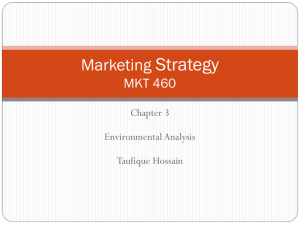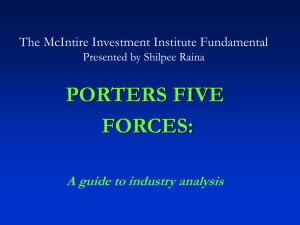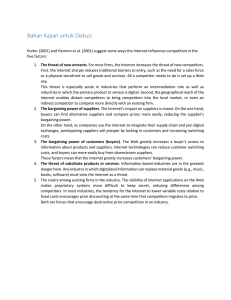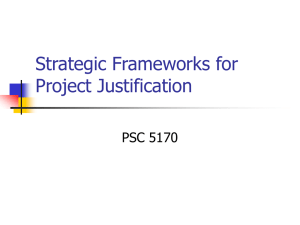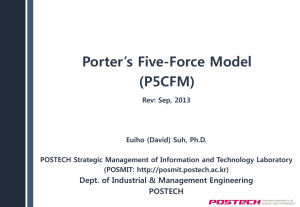Chapter 4
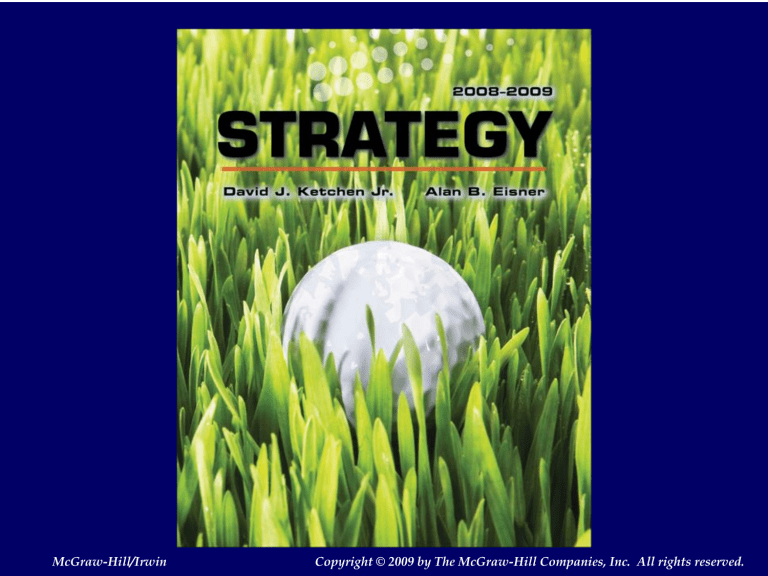
McGraw-Hill/Irwin Copyright © 2009 by The McGraw-Hill Companies, Inc. All rights reserved.
Chapter 4
Analyzing the External
Environment
Learning Objectives
After reading this chapter, you should have a good understanding of:
The impact of the general environment on a firm’s strategies and performance.
How forces in the competitive environment can affect profitability and how a firm can improve its competitive position by increasing its power visà-vis these forces.
How trends and events in the general environment and forces in the competitive environment are interrelated and affect performance.
How the internet and digitally based compatibilities are affecting the five competitive forces and industry profitability.
The concept of strategic groups and their strategy and performance implications.
4-3
Question
All of the following are segments of the general environment except: a) Legal/Political b) Technological c) Ethical d) Sociocultural
4-4
The General Environment
Segments of the general environment include:
Demographic
Sociocultural
Legal/Political
Technological
Economic
General
Environmen t
4-5
The General Environment
General environmental trends and events:
Little ability to predict them
Even less ability to control them
Can vary across industries
General
Environmen t
4-6
Demographic Segment
Aging population
Rising affluence
Changes in ethnic composition
Geographic distribution of population
Greater disparities in income levels
4-7
Sociocultural Segment
More women in the workforce
Increase in temporary workers
Greater concern for fitness
Greater concern for environment
Postponement of family formation
4-8
Political/Legal Segment
Tort reform
Americans with Disabilities Act (ADA)
Repeal of Glass-Steagall Act in 1999
Deregulation of utility and other industries
Increases in federally mandated minimum wages
Taxation at local, state, federal levels
Legislation on corporate governance reforms
(Sarbanes-Oxley Act)
4-9
Example: Sarbanes-Oxley
Sarbanes-Oxley Act is five years young and seems to be having the desired effect
Intended to protect from corporate corruption
In 1981 about 36% of households invested in the stock market; now 54%
Initially the law was "far too bureaucratic"
Since been ironed out by the SEC and the Public
Company Oversight Accounting Board
4-10 www.forbes.com/leadership/2007/08/27/sarbox-regulation-rules-lead-govern-cx_mk_0827oxley.html
Technological Segment
Genetic engineering
Emergence of Internet technology
Computer-aided design/computer-aided manufacturing systems (CAD/CAM)
Research in synthetic and exotic materials
Pollution/global warming
Miniaturization of computing technologies
Wireless communication
Nanotechnology
4-11
Technological Segment -
Nanotechnology
4-12
Example: Nanotech’s Material
Carbon nanotubes become first application to transform nanotechnology
Rolled sheets of graphite, with the ends capped with a soccer ball-shaped carbon structure
Several times stronger and lighter than steel
Electronically, they can be metallic or semiconducting
Nanotubes can be made as ballistic conductors or insulators
4-13 www.forbes.com/personalfinance/2007/05/15/nanotech-arrowhead-intel-pf-guru-in_jw_0515soapbox_inl.html
Technological Segment – Internet
Growth
4-14
Economic Segment
Interest rates
Unemployment
Consumer Price index
Trends in GDP
Changes in stock market valuations
4-15
The Competitive Environment
Segments of the competitive environment include:
Competitors
Customers
Suppliers
Competitive
Environment
Sometimes called the task or industry environment
Porter’s five forces model
4-16
Porter’s Five Forces Model of Industry Competition
Most common analytical tool for examining competitive environment
Five basic competitive forces:
Threat of new entrants
Bargaining power of buyers
Bargaining power of suppliers
Threat of substitute products and services
Intensity of rivalry among competitors in an industry
4-17
Porter’s Five Forces Model of Industry Competition
Five forces model important because:
Helps decide if firm should remain in or exit an industry
Provides rationale for increasing or decreasing resource commitments
Helps assess how to improve firm’s competitive position with regard to each of forces
4-18
Porter’s Five Forces Model of Industry Competition
4-19
Example
Porter’s Five Forces Model: BMW
Threat of new entrants
Very low
Threat of substitutes
Medium, but growing
Power of suppliers
Medium
Power of buyers
Medium, but growing rapidly
Rivalry among existing firms
Very High
Source: Developed from www.bmw.com
4-20
The Threat of New Entrants
Profits of established firms in the industry may be eroded by new competitors
High entry barriers lead to low threat of new entries
Economies of scale
Product differentiation
Capital requirements
Switching costs
Access to distribution channels
Cost disadvantages independent of scale
4-21
Question
If you are considering opening a new pizza restaurant in your community, what would be the threat of new entrants? How would you evaluate
Porter’s other forces for this industry? Explain.
4-22
The Bargaining Power of Buyers
Buyers threaten an industry
Force down prices
Bargain for higher quality or more services
Play competitors against each other
4-23
The Bargaining Power of Buyers
A buyer group is powerful when
It is concentrated or purchases large volumes relative to seller sales
The products it purchases from the industry are standard or undifferentiated
The buyer faces few switching costs
It earns low profits
The buyers pose a credible threat of backward integration
The industry’s product is unimportant to the quality of the buyer’s products or services
4-24
Question
How can suppliers exert power?
a) Increase the amount of materials supplied b) Reduce the quality of purchased goods and services c) Threatening to raise prices d) Both B and C
4-25
The Bargaining Power of Suppliers
Suppliers exert power by threatening to raise prices or reduce the quality goods and services
A supplier group will be powerful when
It is dominated by a few companies and is more concentrated than the industry it sells to
It is not obliged to contend with substitute products for sale to the industry
The industry is not an important customer of the supplier group
4-26
The Bargaining Power of Suppliers
A supplier group will be powerful when
(cont.)
The supplier’s product is an important input to the buyer’s business
The supplier group’s products are differentiated or it has built up switching costs for the buyer
The supplier group poses a credible threat of forward integration
4-27
Question
Substitutes of products and services pose a threat to an industry because they: a) Limit the potential returns b) Places a ceiling on the prices that firms can profitably charge c) Affects the price/performance ratio d) All of the above
4-28
The
Threat of Substitute
Products and Services
Substitutes limit the potential returns of an industry
Ceiling on the prices that firms in that industry can profitably charge
Price/performance ratio
4-29
The Intensity of Rivalry among
Competitors in an Industry
Jockeying for position
Price competition
Rivals easily match price cuts
Advertising battles
Expand overall demand or enhance level of product differentiation
Product introductions
Increased customer service or warranties
4-30
The Intensity of Rivalry among
Competitors in an Industry
Interacting factors lead to intense rivalry
Numerous or equally balanced competitors
Slow industry growth
High fixed or shortage costs
Lack of differentiation or switching costs
Capacity augmented in large increments
High exit barriers
4-31
Using Industry Analysis: A Few Caveats
Company must collect and evaluate a wide variety of information from many sources
Globalization trend, information on foreign markets and a wider variety of competitors, suppliers, customers, substitutes, and potential entrants become critical
Helps a firm to evaluate profit potential and consider various ways to strengthen position
4-32
Using Industry Analysis: A Few Caveats
Five Forces:
Assumes zero-sum game
Determines how a firm can enhance its position
External forces and strategies of individual firms are continually changing
Criticized for being a static analysis
Key role is played by complements
4-33
How the Internet and Digital
Technologies Influences Industry
Threat of New Entrants –Disadvantages the industry
Lower barriers to entry increases number of new entrants
Many internet-based capabilities can be easily imitated
4-34
How the Internet and Digital
Technologies Influences Industry
Bargaining Power of Buyers
Benefits Industry
Reduces the power of buyer intermediaries in many distribution channels
Disadvantages Industry
Switching costs decrease
Information availability online empowers ends users
4-35
How the Internet and Digital
Technologies Influences Industry
Bargaining Power of Suppliers
Benefits Industry
Online procurement methods can increase bargaining power over suppliers
Disadvantages Industry
The Internet gives suppliers access to more customers and makes it easer to reach end users
Online procurement practices deter competition and reduce differentiating features
4-36
How the Internet and Digital
Technologies Influences Industry
Threats of Substitutes
Benefits Industry
Internet-Based increases in overall efficiency can expand industry sales
Disadvantages Industry
Internet-Based capabilities create more opportunities for substitution
Intensity of Rivalry
Disadvantages Industry
Because location is less important, the number of competitors increases
Differences among competitors are harder to perceive online
Rivalry tends to focus on price and differentiating features are minimized
4-37
Strategic Groups within Industries
Two unassailable assumptions in industry analysis
No two firms are totally different
No two firms are exactly the same
Strategic groups
Cluster of firms that share similar strategies
Breadth of product and geographic scope
Price/quality
Degree of vertical integration
Type of distribution system
4-38
Strategic Groups within Industries
Value of strategic groups as an analytical tool
Identify barriers to mobility that protect a group from attacks by other groups
Identify groups whose competitive position may be marginal or tenuous
Chart the future direction of firms’ strategies
Thinking through the implications of each industry trend for the strategic group as a whole
4-39
Strategic Groups within Industries
4-40

